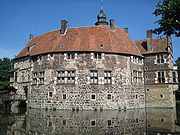
Burg Vischering
Encyclopedia

Lüdinghausen
Lüdinghausen is a municipality in the district of Coesfeld in the state of North Rhine-Westphalia, Germany. It is located on the Dortmund-Ems Canal, approx. 25 km south-west of Münster...
, North Rhine-Westfalia is the most typical moat
Moat
A moat is a deep, broad ditch, either dry or filled with water, that surrounds a castle, other building or town, historically to provide it with a preliminary line of defence. In some places moats evolved into more extensive water defences, including natural or artificial lakes, dams and sluices...
ed castle
Castle
A castle is a type of fortified structure built in Europe and the Middle East during the Middle Ages by European nobility. Scholars debate the scope of the word castle, but usually consider it to be the private fortified residence of a lord or noble...
in the Münster Region of Germany
Germany
Germany , officially the Federal Republic of Germany , is a federal parliamentary republic in Europe. The country consists of 16 states while the capital and largest city is Berlin. Germany covers an area of 357,021 km2 and has a largely temperate seasonal climate...
. This region has one of the highest German concentrations of castles, palaces and fortifications, Lüdinghausen having three by itself. The castle consists of outer defensive courtyard, defensive gateways, moat, drawbridge
Drawbridge
A drawbridge is a type of movable bridge typically associated with the entrance of a castle surrounded by a moat. The term is often used to describe all different types of movable bridges, like bascule bridges and lift bridges.-Castle drawbridges:...
, main building and chapel. The sandstone walls, the red tile roofs as well as their reflection in the moat provide many harmonious views from the wooded surroundings.
Castle Vischering was built by Bischop Gerhard von der Mark to counter the second castle built by the Von Lüdinghausen family. It became the seat of the Droste zu Vischering Family. Droste is the local title for the hereditary noble administrators serving the Bishops of Münster. The moat is constantly replenished by a side-arm of the River Stever. The outer defensive courtyard contains the business and farm buildings. The main building is a horseshoe-shaped three-story structure with heavy outer wall. Its inner courtyard is closed off by the chapel and a lower defense wall. A castle keep
Keep
A keep is a type of fortified tower built within castles during the Middle Ages by European nobility. Scholars have debated the scope of the word keep, but usually consider it to refer to large towers in castles that were fortified residences, used as a refuge of last resort should the rest of the...
is missing, having been removed during Renaissance
Renaissance
The Renaissance was a cultural movement that spanned roughly the 14th to the 17th century, beginning in Italy in the Late Middle Ages and later spreading to the rest of Europe. The term is also used more loosely to refer to the historical era, but since the changes of the Renaissance were not...
renovations. Fire destroyed the castle in 1521. Rebuilding took place on the existing foundation. Windows and the addition of a large bay made the castle more liveable but diminished its defensive character. The whole site however retains the character of a feudal age moated castle. Damage from air attack during World War II
World War II
World War II, or the Second World War , was a global conflict lasting from 1939 to 1945, involving most of the world's nations—including all of the great powers—eventually forming two opposing military alliances: the Allies and the Axis...
was minor.
Castle Vischering houses the Münsterlandmuseum, an exhibit on knighthood for children, as well as a cafe-restaurant. It serves as a cultural center for Kreis Coesfeld. Visiting hours are provided in the first link below. Viewing the outside is possible at all times. The second link provides a more detailed chronology of the castle in German .

